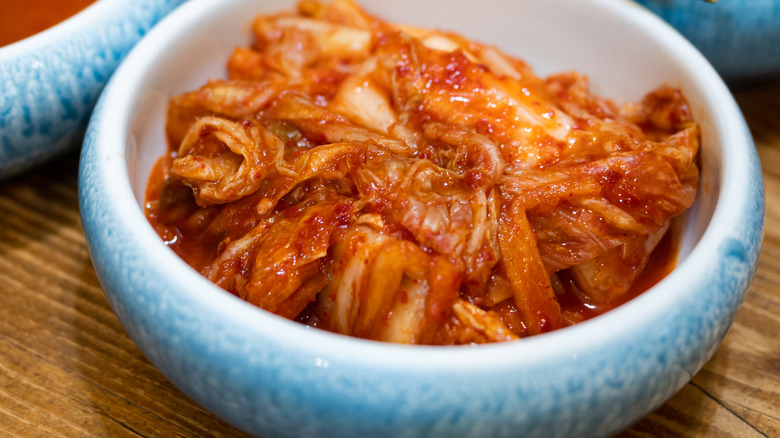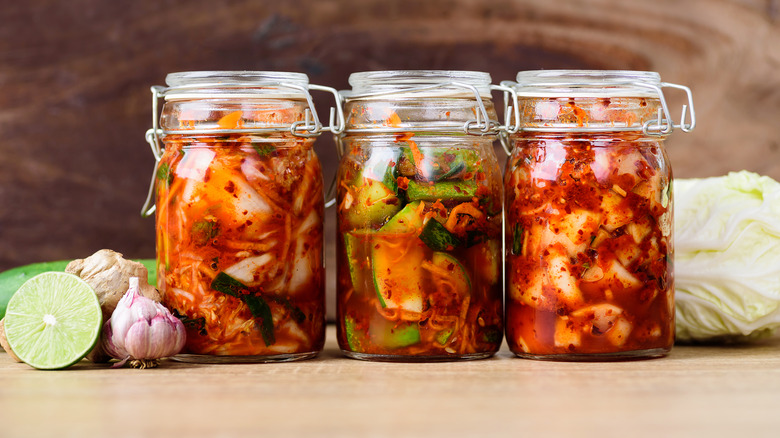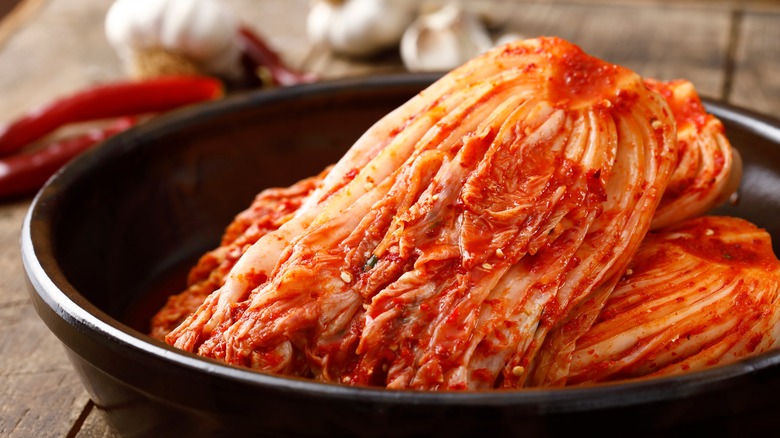The Mistake You Want To Avoid When Thawing Frozen Kimchi
From the pungent flavor to the probiotic benefits, kimchi has become a popular condiment across many cuisines. While that fermented dish can be bubbling with flavor, thawing frozen kimchi is not quite as simple as it seems. Since the dish should not be cooked, it is best to allow the food to slowly arise from the chilly state, either through a water bath or in the refrigerator.
The USDA lays out four safe defrosting methods, refrigerator thawing, cold water thawing, microwave thawing, and cooking without thawing. Since kimchi is not cooked, the final method is off the table. The same is true with the microwave method, which mentions that food thawed in a microwave should be immediately cooked.
If the cold water bag thawing method is chosen, it is imperative to ensure that the storage container is properly sealed. Water seeping into the frozen food can deteriorate the product. In addition, the cold water will need to be changed periodically as the kimchi thaws.
The easiest method is to slowly allow the frozen kimchi to thaw in the refrigerator. As the temperature slowly adjusts, the vegetables are reintroduced to the pickling liquid. Even though the texture can change due to the time spent in the freezer, this gentler method can produce a more palatable product. In the end, prolonging the fermented condiment via freezing is an option, but restoring the food to its original state needs to be thoughtful.
Does freezing kimchi impact the flavor and texture?
While no one wants to waste food, freezing can be a way to extend the product's life. In some cases, that plunge into the deep freeze might not be the best choice. From changing the texture to altering the flavor, the cold can impact the food once it thaws.
Some consumer kimchi brands suggest that kimchi should not be frozen since it can impact the texture and the probiotics. For the fermentation benefits, warmer temperatures are preferred for the bubbling bacteria to thrive. In addition, freezing vegetables causes a change to their cell structure during the change from liquid to solid. When it returns to a neutral state, the vegetable could be flaccid, and the flavor could be weakened.
Bill Kim, chef and owner at Chicago's UrbanBelly and Belly Q, described the various kimchi states to The Takeout. From an orange-tinged aged variety to a bright red, non-bubbly fresh option, appreciating the various states of fermentation can help the cook better use the ingredient. Since kimchi can be stored in a cooler state or at room temperature, the environment will impact the flavor and texture.
For a crunchier, bolder taste, it might be better to keep the jar sealed tight on the counter. Even though this storage location can lessen the overall shelf life, it can lead to optimal flavor enjoyment. The biggest takeaway might be that kimchi is the condiment that should be eaten sooner versus later. No one should find a jar tucked into the dark corner of the freezer or refrigerator.
The most important part to a great kimchi might not be found in a recipe
While some Korean cooks rely on sonmot, the idea of cooking by feel or flavor, creating flavorful kimchi does require a few key ingredients. Generally, the recipe includes cabbage, salt, and pickling liquid. As the ingredients sit, the pungent, sour flavor develops, and the fermentation adds its probiotic benefits. From a spicier option to a more funky variety, cooks can experiment with ingredient combinations and aging periods.
Eric Kim shared one of his recipes with NPR and noted that it is essential for the kimchi to "fart" or otherwise let some of the produced gas escape. Whether it is checking on the fermentation process or having a loose-fitting lid, the ability to let some of the bubbles escape is essential. Although not common, the gas build-up could cause the container to explode. In the end, there are many ways to create a flavorful kimchi, but how the dish is stored will impact the flavor and eating enjoyment.


